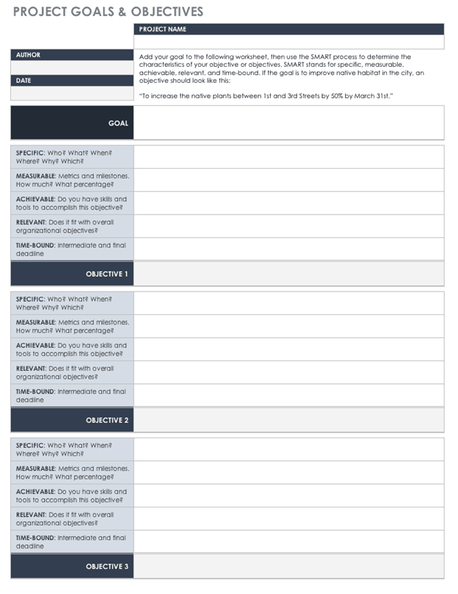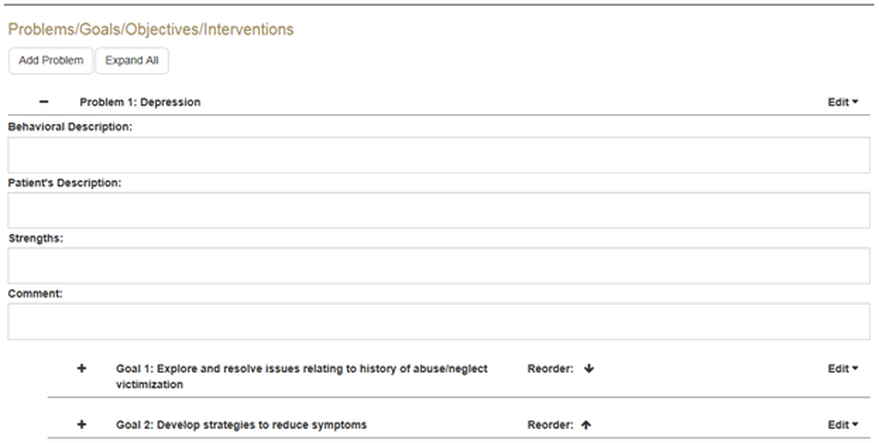Treatment Plans: Setting Goals using the SMART approach
Be SMART:
Objective goals are SMART, not vague
Follow the SMART goals format to help formulate solid, measurable goals that will help both you and the client know what you’re working toward.
SPECIFIC – Who, What, When, Where, and How
• For instance, if you indicate you will be addressing coping skills in treatment, identify specific types of coping skills (anger management, communication, etc.).
• Identify specific clinical interventions you will use.
MEASURABLE – Intensity, Frequency, Duration of Symptoms
• Indicate what sort of objective, quantifiable behavioral indicators will be used to determine if progress is being made in treatment. The measurable component will determine if the goal has been completed. Choose a
quantitative format that best translates what treatment you are hoping to accomplish (Example: “five out of seven days” instead of “60% of the time”).
• Short-term treatment goals work best to show progress over time.
ATTAINABLE – Is the member capable of what is being expected of him/her?
• Is the treatment goal within the client’s power or control?
• Client’s developmental and intellectual abilities should be considered.
REALISTIC – Is your treatment goal a fair expectation?
• Is the bar set too high or too low for this client?
• Is the goal something that a productive, functional member of society would be able to do? (Example: Expecting a “100% reduction in aggression” is not realistic.)
TIME-LIMITED – What is a realistic timeframe to complete the treatment goal(s)?
• “Time-limited” is based on time periods expected of best practices, not never-ending therapy.
• Emphasize gaining the maximum benefit within a specified timeframe.
For Example:
1. Client will reduce anger tantrums at home by learning anger management techniques (self-relaxation, timeouts, stress management) to use daily, as evidenced by no more than 1 reported tantrum per week from aunt and grandmother.
2. Client will learn and implement 3 new calming strategies as part of a new way to manage confrontations with
peers, as evidenced by eliminating physical aggression at school.
3. Client will verbalize emotions related to bio-mother and normalize his experience, by discussing at least 3 related emotions per session.
Objective goals are SMART, not vague
Follow the SMART goals format to help formulate solid, measurable goals that will help both you and the client know what you’re working toward.
SPECIFIC – Who, What, When, Where, and How
• For instance, if you indicate you will be addressing coping skills in treatment, identify specific types of coping skills (anger management, communication, etc.).
• Identify specific clinical interventions you will use.
MEASURABLE – Intensity, Frequency, Duration of Symptoms
• Indicate what sort of objective, quantifiable behavioral indicators will be used to determine if progress is being made in treatment. The measurable component will determine if the goal has been completed. Choose a
quantitative format that best translates what treatment you are hoping to accomplish (Example: “five out of seven days” instead of “60% of the time”).
• Short-term treatment goals work best to show progress over time.
ATTAINABLE – Is the member capable of what is being expected of him/her?
• Is the treatment goal within the client’s power or control?
• Client’s developmental and intellectual abilities should be considered.
REALISTIC – Is your treatment goal a fair expectation?
• Is the bar set too high or too low for this client?
• Is the goal something that a productive, functional member of society would be able to do? (Example: Expecting a “100% reduction in aggression” is not realistic.)
TIME-LIMITED – What is a realistic timeframe to complete the treatment goal(s)?
• “Time-limited” is based on time periods expected of best practices, not never-ending therapy.
• Emphasize gaining the maximum benefit within a specified timeframe.
For Example:
1. Client will reduce anger tantrums at home by learning anger management techniques (self-relaxation, timeouts, stress management) to use daily, as evidenced by no more than 1 reported tantrum per week from aunt and grandmother.
2. Client will learn and implement 3 new calming strategies as part of a new way to manage confrontations with
peers, as evidenced by eliminating physical aggression at school.
3. Client will verbalize emotions related to bio-mother and normalize his experience, by discussing at least 3 related emotions per session.
|
Some example goals & objectives for anxiety could be:
|
Some example goals & objectives for depression could be:
|
|
Treatment Plan Examples and Worksheets
| |||||||||||||||||||||||||||||||||||||
Valant Treatment Plan Tool
Problem: The Diagnosis
Goal: The purpose of therapy (resolution/management/reduction, etc. of the Problem)
Objectives: How the goal is measured to know if treatment is working
Intervention: What the therapist is doing to help the client achieve their goals and objectives
The Problem should only be the diagnosis - anything else you want to say about the problem should be written in the spaces provided below the Problem. For the client's description of the problem, you can copy and paste what the client says the reason for coming to therapy from the Intake Email.
Keep Goals simple - 1-2 goals is sufficient. Same with Objectives - 1-2 is sufficient.
Interventions - what you will be doing to help (example: provide individual therapy using CBT to modify cognitive distortions).
Hint: With the Valant Treatment Plan tool, it helps to Expand All right away to better see the layout.
Goal: The purpose of therapy (resolution/management/reduction, etc. of the Problem)
Objectives: How the goal is measured to know if treatment is working
Intervention: What the therapist is doing to help the client achieve their goals and objectives
The Problem should only be the diagnosis - anything else you want to say about the problem should be written in the spaces provided below the Problem. For the client's description of the problem, you can copy and paste what the client says the reason for coming to therapy from the Intake Email.
Keep Goals simple - 1-2 goals is sufficient. Same with Objectives - 1-2 is sufficient.
Interventions - what you will be doing to help (example: provide individual therapy using CBT to modify cognitive distortions).
Hint: With the Valant Treatment Plan tool, it helps to Expand All right away to better see the layout.
|
| ||||||||||||
Treatment Planning Overview
| treatment_planning_overview.pdf | |
| File Size: | 412 kb |
| File Type: | |
Phases of Treatment Goals
- Acute (6-12+ weeks) Treatment Goals - Achieve response and move towards remission as evidenced by a decrease in symptoms and an improvement in functioning
- Continuation (6-12 months) Treatment Goals - Sustain remission and prevent relapse by targeting any residual symptoms; optimize functioning
- Maintenance (>1 year) Treatment Goals - Sustain recovery and prevent recurrence
Wiley Treatment Planners
Can be used to get ideas. Not written in SMART goal format, but you can easily make the objectives measurable.
|
| ||||||||||||
|
| ||||||||||||
|
| ||||||||||||
|
| ||||||||||||

